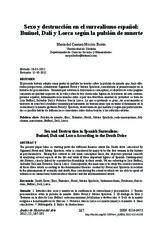Sexo y destrucción en el surrealismo español: Buñuel, Dalí y Lorca según la pulsión de muerte
Autor
Molina Barea, María del Carmen
Editor
Ediciones ComplutenseFecha
2012Materia
Pulsión de muerteEros
Thánatos
Freud, Sigmund, 1856-1939
Spielrein, Sabina
Sado-masoquismo
Fetichismo
Narcisismo
Buñuel, Luis, 1900-1983
Dalí, Salvador, 1904-1989
García Lorca, Federico, 1898-1936
Death drive
Sadomasochism
Fetishism
Narcissism
METS:
Mostrar el registro METSPREMIS:
Mostrar el registro PREMISMetadatos
Mostrar el registro completo del ítemResumen
El presente trabajo adopta como punto de partida las teorías sobre la pulsión de muerte que, bajo diferentes
perspectivas, alumbraron Sigmund Freud y Sabina Spielrein, considerada la primera mujer en la
historia del psicoanálisis. Teniendo por referencia dicho marco conceptual, el objetivo de estas páginas
consistirá en analizar aspectos de la vida y obra de tres destacadas figuras en la historia del arte contemporáneo
español, íntimamente relacionadas entre sí por una fructífera amistad de juventud: se trata de
Luis Buñuel, Salvador Dalí y Federico García Lorca. Lo que se pretende es, pues, un acercamiento al
universo de estos tres creadores teniendo por horizonte las teorizaciones que en torno al fenómeno de la
sexualidad y la muerte gestaron Freud y Spielrein; observando en qué medida y según qué particularidades
es posible hablar de influencias o conexiones entre dichas teorías y los referidos artistas. The present paper takes as starting point the different theories about the Death drive conceived by
Sigmund Freud and Sabina Spielrein –who is considered by many to be the first woman in the history
of psychoanalysis. Taking this context as our main conceptual basis, the objective pursued consists
of analyzing several aspects of the life and work of three important figures of Spanish Contemporary
Art History, closely linked by a productive friendship in their youth. We are referring to Luis Buñuel,
Salvador Dalí and Federico García Lorca. Consequently, the main aim is to study the creative universe
of these three artists according to the fundamental theories created by Freud and Spielrein in relation
to the phenomenon of sexuality and death, thus considering the extent to which we are able to speak of
influences or connections between these theories and the aforementioned artists.

